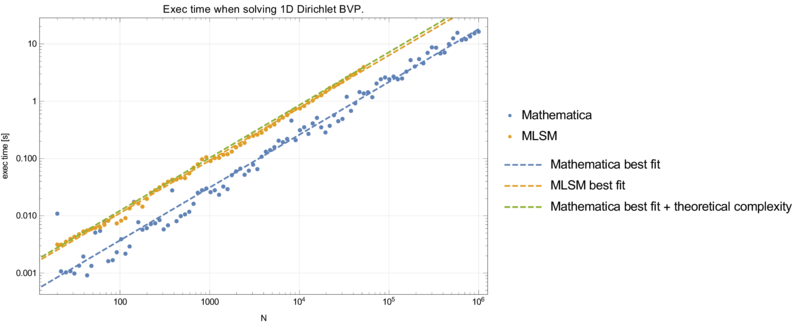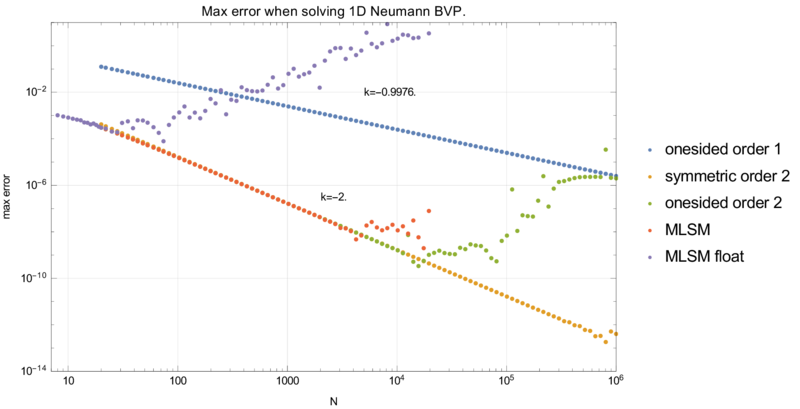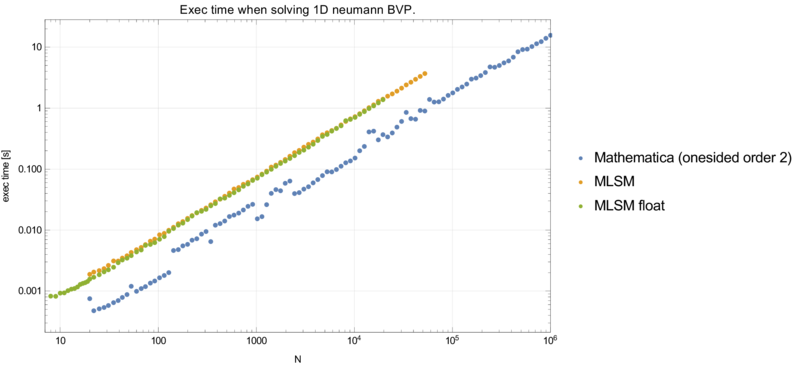Difference between revisions of "1D MLSM and FDM comparison"
(→Neumann case) |
|||
| Line 34: | Line 34: | ||
* onesided finite difference <math>f'(0) \approx (f_1 - f_0) / h</math> | * onesided finite difference <math>f'(0) \approx (f_1 - f_0) / h</math> | ||
* symmetric finite difference <math>f'(0) \approx (f_1 - f_{-1}) / h</math> and normal discretization in node 0 <math>f''(0) \approx (f_1 - 2f_0 + f_-1) /h^2</math> | * symmetric finite difference <math>f'(0) \approx (f_1 - f_{-1}) / h</math> and normal discretization in node 0 <math>f''(0) \approx (f_1 - 2f_0 + f_-1) /h^2</math> | ||
| − | * onesided double finite difference <math>f'(0) \approx (-3/2 f_0 + 2f_1 | + | * onesided double finite difference <math>f'(0) \approx (-3/2 f_0 + 2f_1 -1/2 f_2) / h</math> |
MLSM with support size $n = 3$ and three polynomial basis functions results in exactly the FDM method with onesided double finite difference approximation. | MLSM with support size $n = 3$ and three polynomial basis functions results in exactly the FDM method with onesided double finite difference approximation. | ||
[[File:neucmp.png|800px]][[File:neutimecmp.png|800px]] | [[File:neucmp.png|800px]][[File:neutimecmp.png|800px]] | ||
Revision as of 11:19, 13 March 2017
Different numerical approaches to solving a Dirichlet or Neumann problem
\(
\begin{align*}
\text{Dirichlet} && \text{Neumann} \\
f''(x) &= 2x^2+5 \text{ on } (0, 1) & f''(x) &= 2x^2+5 \text{ on } (0, 1) \\
f(0) &= 1 & f'(0) &= 1 \\
f(1) &= 1 & f(1) &= 1 \\
f(x) &= \frac{1}{6} \left(x^4+15 x^2-16 x+6\right) & f(x) &= \frac{1}{6} \left(x^4+15 x^2+6 x-16\right)
\end{align*}
\)
were analysed. Theoretically, FDM and MLSM should match completely. This is practivaly demonstrated up to certain discretization level.
The interval \([0, 1]\) was always discretized uniformly using $N$ nodes, \(x_i = a+i h, h = (b-a)/N\).
Preliminaries
When solving such problems one usually makes the disretization of the form \(f''(x_i) \approx (f_{i-1} -2 f_i + f{i+1}) / h^2\), but when writing the system of equations, it is usually written as $f_{i-1} -2 f_i + f{i+1} = h^2 g(x_i)$. In the general MLSM formulation it is not possible to always do that and therefore we want to know if there are any numerical differences between solving $f_{i-1} -2 f_i + f{i+1} = h^2 g(x_i)$ and $(f_{i-1} -2 f_i + f{i+1})_h^2 = g(x_i)$. No significant differences were noted.
Dirichlet case
Precision and execution time are summarised in graphs below.
Neumann case
We have more that one possible disctretization of the Neumann BC in point 0. Three explored options are:
- onesided finite difference \(f'(0) \approx (f_1 - f_0) / h\)
- symmetric finite difference \(f'(0) \approx (f_1 - f_{-1}) / h\) and normal discretization in node 0 \(f''(0) \approx (f_1 - 2f_0 + f_-1) /h^2\)
- onesided double finite difference \(f'(0) \approx (-3/2 f_0 + 2f_1 -1/2 f_2) / h\)
MLSM with support size $n = 3$ and three polynomial basis functions results in exactly the FDM method with onesided double finite difference approximation.




